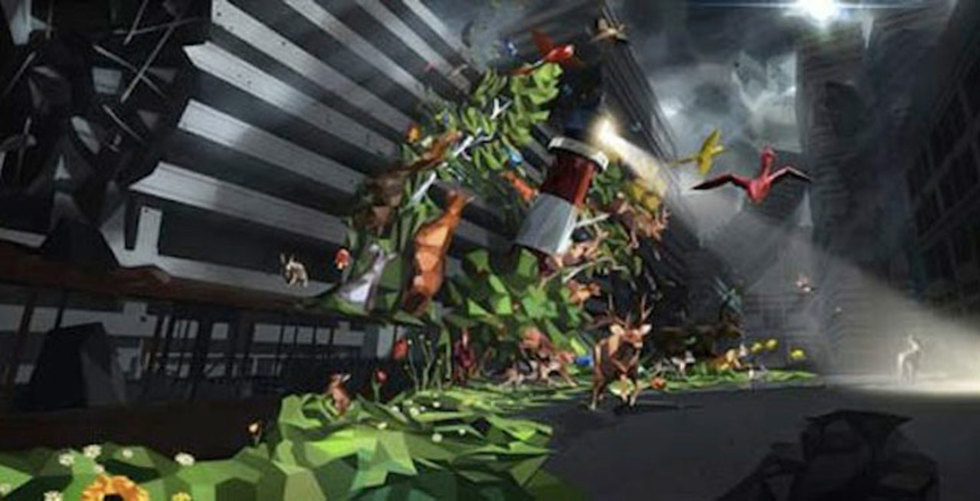
BY BEN MOSKOWITZ |
Exploring the Frontiers of the Recently Possible With HTML5
Emerging technologies like HTML5 and WebGL have the potential to revolutionize storytelling.

You find yourself in a surreal world, flowers blooming over a cityscape as you travel through. In the next moment, a herd of buffalo stampede across a countryside in a dark wave. The visuals are lucid, dreamlike - and most like a dream, you’re the one influencing these dynamically generated images. This is the world of Google Creative Lab’s Three Dreams of Black, an HTML5 music video experience that lets users reshape its landscape, generating new visual experiences in real time.
Three Dreams of Black is just the tip of the iceberg. The web opens up massive potential for completely new kinds of storytelling: documentaries that constantly update with breaking information, storyworlds built and shaped by users, and interactive films that let viewers chart their own path.
Emerging technologies like HTML5 and WebGL liberate film from the constraints of runtime—and there are storytelling opportunities that have yet to be explored or even imagined.
Imagine how the web could supercharge documentary filmmaking, for instance.
Amir Bar-Lev, director of 2010’s acclaimed documentary The Tillman Story, recently won the Silverdocs Transmedia Lab Pitch Award for his plan to bring the film to the web in an “Interactive Edition.”
The Tillman Story chronicles the 2004 death of U.S. Army Ranger Pat Tillman in the war in Afghanistan, the cover-up of the true circumstances of his death, and his family's struggle to unearth the truth.
Inspired by the marginal notes made by Mary Tillman as she pored over documents that might reveal more about what happened to her son, Bar-Lev’s pitch re-imagines the viewing experience as participatory journalism. As the viewer watches, the margins of the film will be populated with B-roll, scanned documents, and additional narrative elements that couldn’t fit into the original cut of the film. The documents are the same ones that Mary Tillman and leading journalists analyzed with great care.
Viewers will be enabled to explore and annotate the documents, navigating the forensic maze at the heart of the story. This approach will "open up the film to scribbling in the margins." And it will affect future viewers' experience of the film.
"It made a lot of sense to make an interactive version of The Tillman Story," says Bar-Lev. "We don't want our film to be considered the final word on Pat Tillman; we want our audience to participate in and interrogate the story."
The challenge is making these elements more than extras and finding ways for them to meaningfully support stories.
There's another challenge. This kind of experimentation is currently the domain of web developers—or at least, for creatives who can afford to hire a web development team. It's not yet easy for creatives to pick up and play with HTML5.
A range of tools are now under development to help ease the creation of these kinds of experiences. Mozilla’s Popcorn.js is an open source software library that makes it easy to sync maps, photos, and other data with video content. Zeega, recently awarded a grant by the Knight Foundation, is a new open source tool for creating interactive, participatory documentary projects. And the recently announced Etherfilms will facilitate non-linear storytelling through the browser.
Open source tools like Popcorn and Zeega will provide filmmakers with a basis for experimentation, and some building blocks to develop their own projects. But there's no substitute for direct collaboration between filmmakers and developers. Working together, filmmakers and developers can achieve amazing creative synthesis. And using the open source model, they can learn and build from techniques that have been pioneered by others.
Events like New York's Open Video Conference are great incubators for this kind of collaboration. The Open Video Conference is a forum where technologists and storytellers to come together for brainstorming, pitching, building, and networking. At OVC, technologists from Mozilla, Google, and elsewhere will be mashed up filmmakers, documentarians, and journalists. The results will be unpredictable, but serendipitous.
If you're interested in exploring the frontiers of the recently possible, it's not too late to register—this year's Open Video Conference takes place September 10-12 at New York Law School in Tribeca.
Three Dreams of Black—and the Tillman Story Interactive Edition, and other web-native films—are on the bleeding edge of the recently possible. But they're also signals of what's to come. When the tools for producing web-native cinema become more distributed and understood, viewers are in for a renaissance in connected storytelling.
